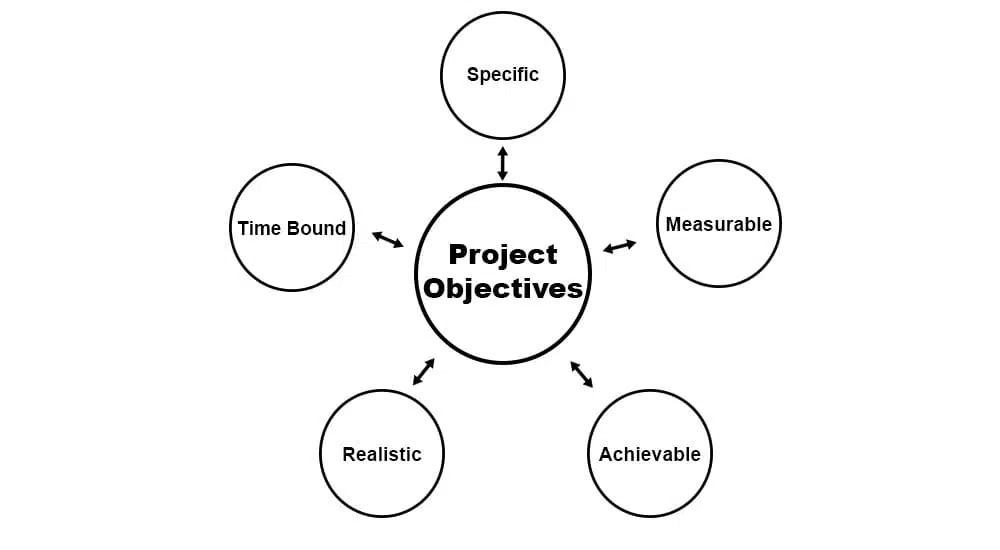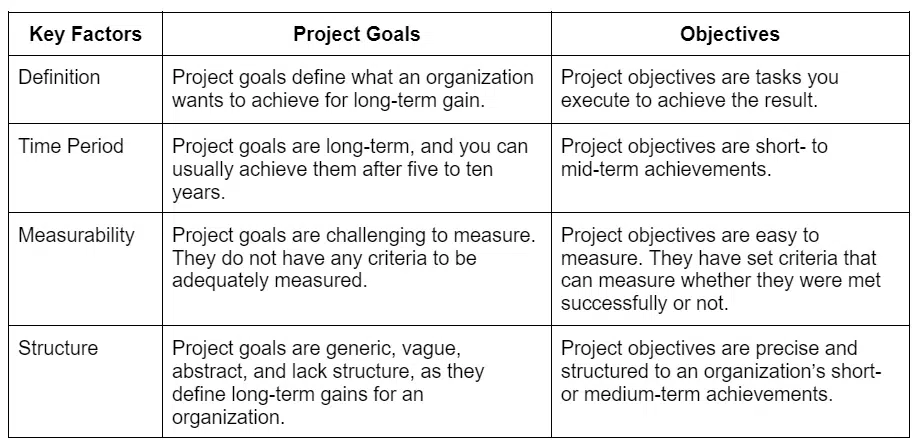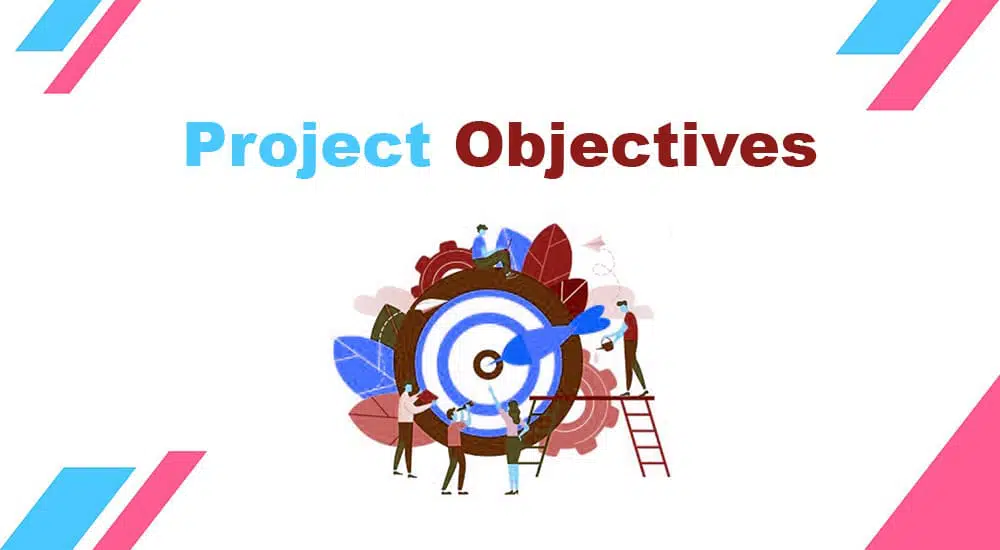Your project is completed, and the project sponsor has accepted the deliverable. But how do you know whether it was successful? Project objectives help you know if your project has achieved success.
If the project has achieved its objectives, it will succeed; otherwise, it will not.
Writing project objectives is easy. However, ensure the project objectives are achievable and measurable and communicate them to the team members.
Today’s blog post will discuss the project objectives, type, example, and how to write it.
Let’s get started.
What Are Project Objectives?

Project objectives are “what” you want to achieve when completing the project. Project objectives are the main purpose of the existence of the project. The project can have multiple objectives, such as achieving the project deliverable within a certain period and given budget.
The project objectives can be tangible or intangible, but they must be achievable and measurable. These are critical parts of project management, and as such, they are vital for successful project completion. Without project objectives, you cannot define your goals, and the team will be directionless.
An effective project objective provides stepping stones for success. This collection of stepping stones is sometimes called “the objective statement.”
Benefits of Project Objectives
A project objective shows what you intend to achieve with the project. It helps the project manager know whether the project is heading in the right direction and aligning with the organization’s goal. Without a project objective, you won’t know whether the project is a success or a failure.
Without project objectives, team members will be clueless about how the project will help the organization grow and where it fits in organizational strategy. They won’t be motivated and perform poorly.
Well-defined project objectives provide direction to the team; they can measure the success and envisage the role of the project in achieving larger organization strategic objectives.
How to Write SMART Project-Management Objectives
The following steps will help write robust project objectives.
#1. Identify Behaviors or Conditions to Change
An organization may have internal challenges or behavior of team members that can affect the project objectives. Assess past projects and identify the behaviors or conditions that must be changed.
Identifying these issues helps project managers prioritize the project objectives. This creates a foundation to build robust and SMART project objectives.
#2. Define “Success”
Management should define the purpose of the project and its objectives, as well as explain how to define success. This way, the team will understand what success looks like. This will provide guidance and motivate them to achieve the project objectives.
To define a project’s “success,” it is essential to write the possible outputs and challenges using SWOT (strengths, weaknesses, opportunities, and threats) analysis.
#3. Describe the Focus
Describe the project’s focus (e.g., lead collection, customer surveys, turnover, sales, profitability, etc.). The focus may differ for each objective. Therefore, it is important to describe the focus to provide the right direction.
For example, suppose a company wants to focus on profitability, minimize plastic waste, and become more eco-friendly. However, these changes will increase manufacturing costs and reduce profitability. Therefore, this problem calls for rethinking that particular project objective.
#4. Include the Location and Time
Mention the timeframe for achieving the objective and location, such as region or country. The time suggests an objective achievement date, such as the third quarter, annually, etc.
#5. Break Down the Objectives
The organization has a lot of information when writing project objectives. Therefore, they must narrow this information and make brief objectives but still contain all necessary information. The best way is to write several versions and select the best one.
A project objective should be a brief, one to four-sentence statement with actionable, measurable elements.
Some best practices for writing project objectives are given below.
- Define the Project Objectives at the Beginning of the Project: Before starting the project, you must define the project objectives when developing the project charter. The project charter must include the project objectives. Project objectives are the foundation of the project-management plan and define the project’s success.
- Involve Stakeholders in Project-Objective Development: While developing the project objectives, you must involve relevant stakeholders (e.g., clients, management, project team members, etc.). This will ensure that the project objectives remain robust and that you will have continued stakeholder support. This, in turn, will help you achieve project objectives with minimal hassle.
- Create SMART Project Objectives: Write brief objectives and avoid adding too many details. The project-objective statement should be around 2-4 lines. Use a SMART framework to write robust SMART objectives. SMART is an acronym that stands for:
- Specific: The objective should be specific to the project. It must not be a generic statement. Outline your requirements with clear statements; do not leave room for misinterpretation. Think of the Five Whys (i.e., Who, Why, What, When, and Where).
- Measurable: The objective should be measurable in terms of KPI so that you will know if you have achieved the objective and to what extent you have achieved it. This will additionally allow the organization to monitor your progress and know when you have achieved the objective.
- Achievable: There is no point in trying to achieve something that cannot be achieved. Therefore, ensure that your project objective is achievable and that all stakeholders are committed to achieving it.
- Realistic: Similarly, the objectives must be realistic for your team to achieve them. An unrealistic objective will only demotivate the project team members.
- Time-Bound: Include a specific date or duration for the project to achieve its objectives and ensure all team members agree.
While writing the project objectives, use plain English, not jargon, so everyone on the team can know the project objective in simple terms
#4. Keep Monitoring Project Objectives
You must ensure the project objectives are always updated throughout the project lifecycle. In your performance reports, connect the progress with the project objectives. Also, communicate the status and progress report on project objectives to your stakeholders.
Project Objective Vs Project Goals
Project goals are at a higher level than the project objectives. Project goals define the outcomes once the project is successfully completed. Goals are not SMART, but objectives are SMART.
A goal is an achievable outcome that is broad and long-term. A project can have multiple high-level goals. A goal should not be specific or vague. For example, “making investors happy to get funding” is not a worthwhile goal. Measuring satisfaction and happiness is difficult and does not serve a business goal.
Objectives are specific and have smaller tasks that serve the broader goal. Goals are essential, but objectives power the engine.
Examples of acceptable project goals are:
- We will boost website traffic every year.
- We will grow our sales over the next five years.
- We will increase our product efficiency.
Examples of acceptable project objectives are:
- We will boost website traffic by 20% over the next three years.
- We will grow our sales by 15% over the next five years.
- We will increase our process efficiency by 30% over the next three months.

Project Objectives Vs Business Objectives
Project objectives are limited to the project. They guide project managers and team members to achieve small milestones on their way to project completion. Business objectives have a larger scope. They are much bigger than the project objectives, and they guide business growth for the longer term. Project objectives should align with the business objectives.
Business objectives guide business and provide direction to the business way forward. Business objectives are for long-term business success.
An example of a business objective is to “capture the market share by 50% within one year.”
Project Objectives Vs Project Plan
Project objectives are two to four-line statements. The project plan is a detailed plan of how you will complete the project. The project plan comprises many subsidiary plans such as scope management plan, quality management plan, cost management plan, risk management plan, etc.
The project plan explains all the tasks you will undertake to complete the project.
Project Objectives Vs Project Milestones
Project objectives are what you want to achieve with the project, and project milestones are the project events. For example, completing the first floor within three months, fixing the plumbing work in four months, etc.
Milestones are checkpoints and represent key project achievements.
Project Objectives Vs Project Deliverables
Project deliverables are outcomes you get after completing the project. You can also deliver the project deliverables during the project life cycle.
The project objectives define the project deliverables.
Example of project deliverable: A website mockup can be a deliverable for a website designing project, and the complete website design is the final project deliverable.
Types of Project Objectives
The project objectives can be of the following types:
#1. Performance Objectives
Project performance objectives help measure and evaluate the project’s progress and outcomes. You define these objectives early in the project planning phase.
Project performance objectives should be clear, measurable, and aligned with the purpose and organizational goals.
Some project performance objectives are as follows:
- Scope Objectives: These objectives define the ins and outs of the project. You can see what is included and excluded in the project. Scope objectives include scope baseline.
- Schedule Objectives: Schedule objectives define the project timeline. They include schedule baseline, project milestones, deadlines, and project duration.
- Cost Objectives: Cost objectives define the project budget and cost-control measures. They include cost baselines, budget limits, targets, and control measures.
- Quality Objectives: Quality objectives define the quality metrics of the project and its deliverables.
- Performance Metrics and KPIs: Key performance indicators (KPIs) and metrics track progress and success in various aspects of the project (e.g., productivity, efficiency, and customer satisfaction).
#2. Business Objectives
Project business objectives are specific to a project’s financial and strategic aspects. These objectives focus on how the project will contribute to the organization’s success from a business perspective.
Project business objectives justify the investment in the project and ensure that it aligns with the organization’s strategic priorities.
Some business objectives are as follows:
- Market Positioning: For projects involving new products or services, business objectives can include gaining a competitive edge, entering new markets, increasing market share, enhancing the organization’s market positioning, etc.
- Customer Satisfaction: Projects may have business objectives for improving customer satisfaction, loyalty, and retention. Satisfied customers are more likely to generate repeat business and referrals.
- Operational Efficiency: These objectives include streamlining operations, enhancing productivity, and optimizing resource utilization. Projects can aim to improve internal processes and reduce waste.
- Revenue Growth: Project business objectives often include revenue-growth targets. This could involve launching new revenue streams, expanding existing ones, or entering new markets to generate additional income.
- Market Expansion: Expanding into new geographical regions or demographic segments can be a business objective. This requires projects that support such expansion efforts.
- Customer Acquisition: For startups and businesses in growth phases, acquiring new customers may be a primary business objective, and projects may be initiated to drive marketing and sales efforts.
#3. Financial Objectives
The project’s financial objectives are specific to the financial outcomes associated with the project. These objectives focus on the project’s financial aspects (e.g., budgeting, cost management, revenue generation, and return on investment [ROI]).
Some financial objectives are as follows:
- Return on Investment (ROI): ROI is a key financial metric that measures a project’s profitability. Financial objectives may include achieving a specific ROI within a defined period.
- Profit-Margin Improvement: Projects may target profit-margin improvements by optimizing pricing strategies, reducing production costs, or increasing sales efficiency.
- Cashflow Management: Ensuring positive cash flow throughout the project’s lifecycle is critical for its financial health. Objectives may involve managing cash inflows and outflows effectively.
- Payback Period: The payback period is the time that it takes for a project to recoup its initial investment through generated profits. Financial objectives may aim to achieve a specific payback period.
- Cost-Benefit Analysis: Projects may be required to undergo a cost-benefit analysis to assess whether the expected benefits outweigh the costs. Financial objectives may involve achieving a favorable cost-benefit ratio.
#4. Quality Objectives
These objectives define the level of quality that a project is expected to achieve. Quality objectives ensure the project’s deliverables meet the required standards and satisfy customer expectations.
- Specification Conformity: You must ensure that project deliverables conform to the pre-established requirements, standards, and specifications. This includes meeting technical, functional, and performance criteria.
- Customer Satisfaction: Quality objectives prioritize customer satisfaction. This involves meeting or exceeding customer expectations and delivering a product or service that meets their needs.
- Defect Prevention: A key quality objective is identifying and preventing defects or errors early in the project lifecycle. This may involve testing, validation, and other quality control processes.
- Process Improvement: Quality objectives may include improving project management and development processes to enhance the overall project quality.
5. Technical Objectives
The project’s technical objectives focus on developing, implementing, or enhancing technical systems, products, or processes.
Some technical objectives are as follows:
- Product Development: These objectives include designing, developing, and testing the product to meet specified requirements.
- Technology Adoption: Some projects aim to adopt new technologies or upgrade existing ones. Technical objectives may involve successfully integrating new technology into the organization’s operations.
- Performance Improvement: Technical objectives may aim to enhance the performance of existing systems, processes, or equipment. This could involve optimizing system speed, reliability, or efficiency.
- Security and Data Protection: Projects often include cybersecurity and data protection objectives. These objectives focus on safeguarding sensitive information and ensuring the security of technical systems.
- Testing and Validation: Technical objectives often include testing-and-validation processes to ensure that technical deliverables meet specified requirements and perform as expected.
Examples of Project Objectives
A few examples of project objectives are given below:
Example of a Performance Objective
Our sales team plans to increase revenue by 20% by mid-year by offering consumers 1% more coupons in their mailboxes and inboxes. We will track sales using the coupons at the end of each quarter.
Example of a Business Objective
By December 2023, our senior web development team will develop a remodeled website (e.g., a new logo), which will require an additional eight hours of work per week. Every Monday, they will give us an updated report on what they have achieved and what they still need to finish. We are allotting a budget of $6,000 USD for them to complete the project.
Example of a Regulatory Objective
Our objective is to create single-use products that are more sustainable for the environment, following the state’s recently passed sustainability legislation. By August 2023, we plan to have single-use straws, containers, and utensils that are more environmentally friendly.
We plan to use bamboo for these products because it is manufactured mechanically instead of chemically. We will conduct weekly production inspections to ensure the project progresses on time.
Conclusion
Project objectives define a project’s success, provide clear expectations to stakeholders, and allow the project team to complete the project with the least hassle. Project objectives also make it possible to track the project’s progress. Finally, project objectives align the project with the organization’s overall goals.

I am Mohammad Fahad Usmani, B.E. PMP, PMI-RMP. I have been blogging on project management topics since 2011. To date, thousands of professionals have passed the PMP exam using my resources.







